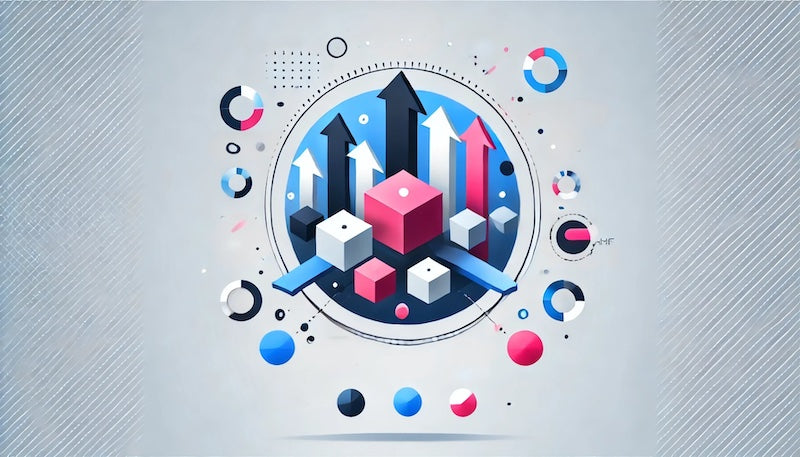Often, small adjustments to your Shopify store are enough to improve the user experience and positively impact your relevant key performance indicators (KPIs). What levers do the most successful brands use on Shopify, and what can you learn from them?
In this article, we'll share five practical tips to take your customer journey to the next level. The insights and examples are based on tante-e founder Adrian's experience working with numerous e-commerce brands.

Our e-commerce expert Adrian has already helped numerous brands launch on Shopify. In his book, Shopify for Dummies, he provides retailers with all the essential information they need to navigate Shopify ( view on Amazon / view at your local bookstore ).
1. The most important KPIs for your Shopify store
Regularly analyzing key performance indicators (KPIs) is one of the key factors for continuously optimizing your Shopify store and achieving long-term success. KPIs aren't just numbers—they're the metrics that show you how well your store is actually performing. They help you make data-driven decisions and make targeted adjustments that will sustainably increase your sales and profits.
In our daily work as a Shopify agency, three key KPIs have proven particularly valuable for measuring and specifically increasing the success of an online shop:
- Conversion Rate (CR)
- Average Order Value (AOV)
- Repurchase rate
Before we get to our examples and strategies, let's break down what we mean by these KPIs.
1.1. Conversion Rate (CR): The key to sales success
The conversion rate is one of the most important metrics in e-commerce. It indicates how many of your store's visitors actually become paying customers. Simply put, the conversion rate shows the percentage of visitors who perform a specific action—usually purchasing a product.
Why is the conversion rate so crucial?
The conversion rate is so important because it's arguably the most direct indicator of the effectiveness of your marketing and sales efforts. A low rate may indicate barriers to purchase, such as unclear product descriptions, a lack of trust, slow loading times, or complicated checkout processes.
The conversion rate is calculated very easily:
Conversion Rate (%) = (Number of Sales / Number of Visitors) x 100
For example, if 1,000 visitors enter your Shopify store and 25 of them make a purchase, your conversion rate is 2.5%.
What is a good conversion rate?
The question of what a “good” conversion rate is cannot be answered in general terms, as it depends heavily on the industry, product type and target audience of your Shopify store.
In our experience, the average conversion rate for e-commerce shops is between 1% and 3%. However, there are also shops that achieve significantly higher rates, especially those operating in specialized niches. For example, conversion rates of 5% are common in the food sector.
1.2. Average Order Value (AOV): The revenue driver
The average order value (AOV) refers to the average order value a customer spends on an order in your online store. It is calculated by dividing total sales by the number of orders. AOV is an important KPI because it directly influences sales and is an indicator of how much value customers place on your product offering.
Why is the AOV important?
A higher AOV means more revenue per customer and thus higher profitability for your store, without having to incur additional marketing costs for new customers. By taking targeted measures to increase AOV, you can significantly increase your profits, even if the number of visitors or conversion rate remains unchanged.
The formula for calculating the AOV is:
Average Order Value = Total Sales / Number of Orders
Example: If your Shopify store generates €10,000 in sales in a month and you have had 200 orders, the AOV is €50.
Shopify makes it especially easy to keep track of your numbers in Analytics . Learn more in our blog.
1.3. Repurchase rate: customer loyalty as a success factor
The repurchase rate is a crucial KPI for measuring customer loyalty in your Shopify store. It shows you how many people buy from you again and is therefore a direct indicator of your customer satisfaction and loyalty. A high repurchase rate indicates that your products and customer service are impressive, while a low rate may indicate that there is potential for improvement.
Why is the repurchase rate so important?
Repeat customers are incredibly valuable to your business. Not only do they generate recurring revenue, but they're also more cost-effective than new customers, as you don't incur additional marketing costs to acquire them. Furthermore, loyal customers often tend to spend more because they have more trust in your brand and your store.
A high repurchase rate therefore positively impacts your customer lifetime value (CLV), which is crucial for the long-term success of your Shopify store. Furthermore, satisfied customers encourage word-of-mouth recommendations, which in turn attract new customers.
5 proven best practices to improve your Shopify KPIs
How do successful Shopify brands optimize their Shopify store's most important KPIs? Using store examples, we'll show you five proven strategies to optimize your customer journey and encourage customers to buy.
Tip 1: Simplify your user journey
A successful online store knows how to guide visitors to the desired products as quickly and easily as possible. Using Kloster Kitchen as an example, we'll take a closer look at how the customer journey can be significantly simplified:

For example, customers can create their own 12-pack of different flavors of ginger shots. Typically, they would have to click through the product pages for each variant to see details about the available options. This can be tedious and time-consuming. The risk increases that customers will leave the store before discovering all the relevant products.
The solution: Kloster Kitchen presents all flavors, including relevant details, clearly on one page. Customers can easily compare the different options and add their selections to the bundle. Additional information such as spiciness, sweetness, fruitiness, and nutritional values are available directly via a pop-up, without customers having to leave or switch pages.
This popup also integrates social proof in the form of customer reviews to make the purchase decision easier.
So the advantages are:
- Improved customer experience: Customers find the products they want faster and easier.
- Higher conversion rate: The clear presentation, simple selection and trust-building elements encourage customers to buy more.
- Reduced bounce rate: Customers leave the shop less often because they find all relevant information on one page.
What does the ideal Shopify store structure look like for a smooth customer journey? Learn more in our blog.
Tip 2: Simplify decision-making
Making purchasing decisions can be challenging for customers, especially when it comes to products that require education and information. XbyX specializes in herbal solutions for menopause and simplifies product selection through various strategies.

To avoid overwhelming and unsure customers who aren't familiar with the product range, XbyX offers pre-made bundles and sets that are specifically tailored to the needs of the target audience.
These packages contain a selection of products that complement each other and precisely meet the needs of the customers. For example, there are targeted bundles for anti-stress, sleep problems, or intestinal balance. In addition, XbyX provides informative content in the form of guides and brochures that deepen knowledge about the products and their use.
XbyX also integrates interactive self-tests. After customers answer a few questions via a form, they receive personalized product recommendations that precisely match their needs.
This results in the following advantages for XbyX:
- Increased willingness to buy: The prefabricated sets facilitate the purchase decision and reduce customer uncertainty.
- Increase in average shopping cart value: By purchasing a bundle, customers spend more money than when buying individual products
- Increased satisfaction: Personalized advice leads to greater satisfaction and increases the likelihood of repeat purchases.
- Lead generation: Self-tests can be used to collect email addresses and involve potential customers in marketing activities.
Tip 3: Use storytelling
Storytelling is a powerful method for increasing the perceived value of your products. Successful e-commerce brands no longer use their online stores as a mere sales platform. Rather, it's about conveying the value of your products to customers through an engaging story. The better they get to know you and your brand and are convinced of your values, the more likely they are to shop with you. We take a look at how the food brand Buah effectively incorporates storytelling:

Buah is known for its freeze-dried fruits. Due to the manufacturing process, these products are in the higher price segment. The problem here is often that customers are hesitant to pay this price if they don't see the added value of the product.
Effective storytelling can counteract this. Buah, for example, provides contextual information about the origin and the complex production process on the product page. Overall, the brand illustrates the special properties of the fruit. Visual elements such as icons and videos support the story and make it even easier for visitors to understand.
In addition, detailed “About us” and “Team” pages illuminate the personal backgrounds of the founders to create greater proximity.
This is how Buah benefits from targeted storytelling:
- Transparency: Customers get a clear understanding of what makes the product so special and why the price is justified.
- Perceived added value: The story draws attention to the quality, sustainability and special features of the product.
- Emotional connection: The personal touch and the story behind the product create an emotional connection.
Tip 4: Increase the average shopping cart value
Increasing the average shopping cart value is a proven method for boosting an online store's sales. The goal is to encourage customers to purchase more products per order. But how can you go about it? We'll give you inspiration using the example of 3Bears .

3Bears, a porridge brand, demonstrates various strategies to increase the average basket value, including gamification and free shipping limits.
For example, there's a progress bar for free shipping in the shopping cart, which playfully encourages customers to add more products to reach the free shipping threshold.
In general, offering free shipping on orders over a certain value is considered a proven method to encourage customers to purchase additional products. Additional goodies such as free products or exclusive content also serve as an additional incentive.
This results in the following advantages for 3Bears:
- Higher revenue per order: By increasing the average shopping cart value, revenue per customer is increased.
- More efficient logistics: Larger orders can be packed and shipped more efficiently, reducing costs.
- Increased satisfaction: Customers appreciate free shipping offers or additional goodies and feel valued.
Tip 5: Increase Customer Lifetime Value
A high customer lifetime value (CLV) is the ultimate goal for many online retailers, as it ensures long-term profitability. It's about encouraging customers to make repeat purchases and thus building lasting relationships.

The natural cosmetics brand nkm , for example, uses subscriptions to increase customer loyalty and encourage regular purchases. The subscription option is prominently displayed on the product page. Benefits such as discounts and flexible cancellation options are also clearly highlighted. Customers can individually specify the delivery window and then add the product subscription to their shopping cart.
An intelligently integrated subscription model results in:
- Predictable income: Subscriptions generate regular and predictable income for you
- Closer loyalty: Subscription customers are more closely tied to the brand and are less likely to buy from competitors.
- Higher customer lifetime value: Through repeated purchases, subscription customers spend more money over time than sporadic buyers.
You now know the most important KPIs for your Shopify store that you should definitely keep an eye on. You also have five best practices as concrete approaches that will help you lay the foundation for sustainable growth.
Keep in mind that optimizing the customer journey in your Shopify store is an ongoing process. Over time, you'll discover which methods work best for your target audience and which strategies are best to focus on.
Looking for even more inspiration? Our list of the top Shopify stores reveals what you can learn from the most successful German online retailers.


